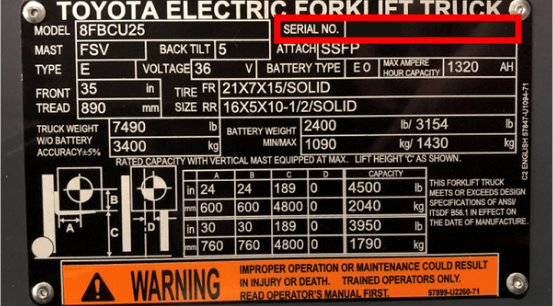A History Of Toyota Forklifts

Sakichi Toyoda, born in 1867, was the son of Ikichi and Ei Toyoda. From an early age, Sakichi had a passion for learning and a desire to contribute to society by creating new and valuable inventions. Through hard work and perseverance, he quickly becomes known as a prominent inventor in Japan after obtaining patents for the Toyoda wooden handloom and Toyoda power loom.
Sakichi Toyoda Revolutionizes Manufacturing
Over the years, Sakichi continued to invent more sophisticated and advanced looms and eventually established Toyoda Automatic Loom Works, Ltd. in 1926. Although their primary function was the invention and manufacture of looms, the company had larger aspirations of broader research and innovations outside the textile industry. This drive led to the company’s significant business diversification efforts that resulted in the eventual design and production of engines, automobiles, air compressors, and, of course, forklifts. In 1936, the name change from “Toyoda” to “Toyota” occurred because the latter can be written with eight strokes in Japanese katakana. Eight is regarded as a lucky number in East Asian culture.
First Forklift Was Invented by Toyota Motor Sales Co.
Toyota began the development of its first lift truck in 1955. By 1956, the model LA 1-ton internal combustion engine counterbalanced forklift was launched through Toyota Motor Sales Co. (currently Toyota Motor Corporation). The lift truck market grew rapidly in the 1960s, and in 1970 Toyota established a dedicated factory for the production of industrial vehicles in Takahama, Japan. Over 1 million square foot parcels of land, this facility is still used to this day as Toyota forklift’s headquarters and main manufacturing facility. In 1970, Toyota systemized the Toyota Production System (TPS) based on two main ideologies: “Just-in-Time” and “Jidoka (automation with a human touch).” While TPS has evolved, it is currently a world-renowned philosophy practiced at all Toyota production facilities worldwide.
Forklift Innovations Throughout the 20th Century
Throughout the 1960s and 1970s, more diversified products began to be designed and manufactured, including diesel and electric forklift fleets, models with lift capacities of up to 40 tons, and even an extensive lineup of forklift attachments and options. Increasing global demand for these products led to the first Toyota forklift sale in the United States in 1967.
As the number of exports to the US grew, the need for an overseas manufacturing facility became apparent. In 1988, Toyota Industrial Equipment Manufacturing (TIEM) was established as a joint venture with Toyota Motor Sales in Columbus, Indiana, with production beginning in 1990. By 1995, Toyota’s forklift production had reached 1 million units globally and was still going strong. The acquisition of BT Industries AB of Sweden and the introduction of the world’s first AC-powered electric forklift in 2000 further bolstered sales and market share.
Creation of Toyota Material Handling
To unify manufacturing and marketing, and sales operations, Toyota Material Handling was established in 2001 under Toyota Industries Corporation (TICO) with separate divisions across the globe, including Toyota Material Handling, USA (TMHU) in North America. That same year, Toyota attained first place in global market share, and by 2002, it had also achieved first place in the US market share, both distinctions that are still held to this day.
In April of 2006, Toyota Material Handling Group (TMHG) was created to facilitate the integration of Toyota Material Handling and BT Industries Group. This joint venture improved global competitiveness and allowed the companies to realize synergies by mutually supplying each other’s products, engaging in collaborative development, reorganizing sales and service networks, and sharing production expertise.
Toyota Acquires Top Forklift Providers
These synergies allowed Toyota to continue positioning itself as a true full-line supplier of material handling equipment. Reach trucks, order pickers, tuggers, pallet jacks, and more joined Toyota’s lineup of premier sit-down counterbalanced products throughout the 2000s. In 2003, the AICHI Corporation became a subsidiary of Toyota, adding a diverse offering of aerial work platforms and construction equipment to the product mix. Cascade Corporation, the world leader in designing and manufacturing material handling attachments and accessories, was later acquired in 2013.
In addition to being a full-line supplier of material handling equipment, Toyota also continues to position itself as a premier material handling solutions provider. TICO’s acquisition of Bastian Solutions, LLC and Vanderlande in 2017, for example, signifies Toyota’s strategic ambition to increase its presence in automated material handling, systems integration, and advanced logistics technology.
This dedication to innovation and diversification started with Sakichi Toyoda’s vision over 100 years ago. What began as one man’s dream and a small loom manufacturing company has evolved into one of the world’s largest and most recognized companies. Sakichi passed away in October 1930 after dedicating 63 years to invention, but his spirit still lives on in all Toyota companies. His lasting legacy will continue to inspire us all for years to come.
Toyota forklifts continue to be considered the top choice for business owners across the globe. If you are ready to get the most out of your forklift and fleet, turn to Toyota. Contact a Toyota forklift dealer today to find your best forklift option.


